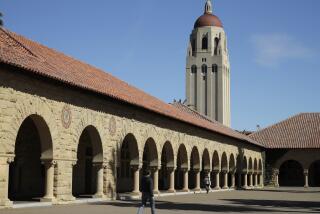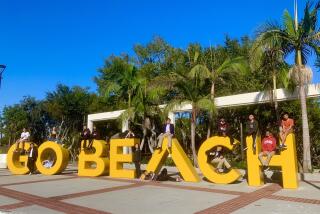Obama encourages economic diversity in higher education
More than 100 colleges and universities, including several in California, promised Thursday to try to attract more low-income students by strengthening relationships with high schools and community colleges, increasing access to advisors and offering more remedial programs.
The pledges came after President Obama made increased college accessibility one of his top goals. On Thursday, the president invited to the White House participants who have made commitments to further that effort.
Obama said that higher education was the best way to ensure more economic opportunity.
“More than ever, a college degree is the surest path to a stable, middle-class life,” the president said at the White House summit.
Last summer, the president also called for new incentives to push colleges to adopt programs that could reduce costs, such as offering three-year degrees, and proposed expanding an income-based student loan debt repayment plan.
During the daylong event, both the president and First Lady Michelle Obama said they benefited from programs to attract low-income students who may not have had much exposure to higher education.
“I know that there are so many kids out there just like me — kids who have a world of potential, but maybe their parents never went to college or maybe they’ve never been encouraged to believe they could succeed there,” said the first lady, who went to Princeton University and Harvard Law School.
Several companies and nonprofit groups pledged additional funds for programs after being contacted by federal officials.
The nonprofit Posse Foundation raised $70 million that will provide scholarships to 500 students, said Deborah Bial, the group’s president.
“That would not have happened if the White House didn’t call,” she said.
Many college officials say they have already made increased diversity a top goal but that the president’s urging would help them work collaboratively.
“We have been working on this problem for a long time, but there are still many challenges,” said Claremont McKenna College President Hiram Chodosh.
Of the nearly 1,300 Claremont students, about 200 are black or Latino.
Claremont officials plan to raise $100 million for financial aid and to recruit more students from middle- and lower-income families. Administrators also plan to study how students perform academically after taking certain programs and classes, Chodosh said.
Pomona College officials intend to increase the percentage of students who receive Pell grants, which are aimed at lower-income students, and to accept more community college transfers, according to officials.
Pomona currently takes up to four community college students per year, and plans to increase that number to between seven and 10 annually by building relationships with some two-year schools.
Other schools that agreed to increase their outreach include Yale University, Georgetown University, and the University of North Carolina.
The California State University system will spend $8 million to hire 70 more advisors on campuses and spend another $8 million to expand its summer program for incoming freshmen. Chancellor Timothy P. White said he hoped the Cal States would work with community colleges and the UC system to create a way to track students as they move between their campuses.
“We’ve been talking about reinvigorating our partnerships,” White said.
Each of the nine University of California undergraduate campuses will expand outreach to low-income high school and community college students and increased financial and academic support, according to officials.
Whittier College administrators will offer free advanced calculus and an intensive writing seminar to high school students as well as working with community colleges.
Whittier President Sharon Herzberger said the cost “would not be astronomical, but it’s something we want to do and we think it will bring a lot of benefit.”
jason.song@latimes.com
More to Read
Start your day right
Sign up for Essential California for news, features and recommendations from the L.A. Times and beyond in your inbox six days a week.
You may occasionally receive promotional content from the Los Angeles Times.







